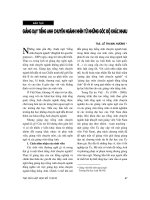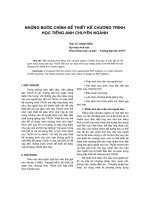Tiếng anh chuyên ngành topic sport sponsorship
Bạn đang xem bản rút gọn của tài liệu. Xem và tải ngay bản đầy đủ của tài liệu tại đây (1.86 MB, 18 trang )
<span class="text_page_counter">Trang 1</span><div class="page_container" data-page="1">
1
<b>THƯƠNG MẠI</b> UNIVERSITY
<b>KHOA QUẢN TRỊ NHÂN LỰC </b>
</div><span class="text_page_counter">Trang 2</span><div class="page_container" data-page="2"><b>Bảng thành viên và phân công nhiệm vụ </b>
3 <sub>Vũ Thị Phương Anh </sub> 2.1 + Intro + PPT
6 <sub>Nguyễn Thị Ánh Chúc </sub> 2.4 + Conclusion + PPT
</div><span class="text_page_counter">Trang 3</span><div class="page_container" data-page="3">I. Introduction ... 4
II. Sports sponsorship ... 5
2.1. Basics of Sport Sponsorship ... 5
2.1.1. What is sports sponsorship? ... 5
2.1.2. What types of sports sponsorship are there? ... 5
2.2. Advantages and disadvantages of sports sponsorship ... 6
2.2.1. For athletes ... 6
2.2.2. For sponsors ... 8
2.3. The Best Sports Sponsorship Examples ... 9
2.4. Sports sponsorship ideas for clubs in the university ...13
2.4.1. How to call for sponsorships ...13
2.4.2. The benefit for student ...15
III. Conclusion ... 17
References ...18
</div><span class="text_page_counter">Trang 4</span><div class="page_container" data-page="4">I. INTRODUCTION
Sports sponsorship has become an integral part of the sports industry, as it offers a mutually beneficial partnership between companies and sports entities. It involves the financial support and resources provided by a sponsor to a sports team, event, or individual in exchange for advertising and promotional opportunities. This collaboration allows companies to enhance their brand visibility, reach a targeted audience, and associate their brand with the excitement and passion of sports. On the other hand, sports entities benefit from the financial backing, which helps them thrive and achieve their goals. This introduction will delve into the world of sports sponsorship, exploring its significance, the different types of sponsorships, and the impact it has on the sports industry as a whole.
Group 1 chooses a topic that plays an essential role in the world of sports - Sports Sponsorship. This concept is not just about logos on jerseys or banners at stadiums. It's a symbiotic relationship that provides mutual benefits for both the sponsor and the sponsored entity.
</div><span class="text_page_counter">Trang 5</span><div class="page_container" data-page="5">II. SPORTS SPONSORSHIP
2.1. Basics of Sport Sponsorship2.1.1. What is sports sponsorship?
According to the BBC, sports sponsorship is defined as the financial support for a sport (whether this is an event, organization or performer) by an outside body (be it a person or organization) for the mutual benefit of both parties. This sponsorship occurs at all levels of sport. Sponsorship can be financial or in-kind payments. Sponsorship means both parties receive benefits from the agreement.
2.1.2. What types of sports sponsorship are there? There are 4 main types of sports sponsorship:
Individuals sponsorships: Display a logo, wear a particular brand, endorse products, pay training, competition and travel costs.
Example: the partnership between Nike and NBA legend Michael Jordan
Teams and clubs sponsorships: Wear kit, display banners, have a company name for the team or for the ground or for a stand/court in the ground, pay competition and travel costs.
Example: In 2015, Adidas signed a record-breaking 10-year, $1.3 billion sponsorship deal with the English Premier League soccer club, Manchester United
Sports sponsorships: Rename competitions, cups and leagues, brand their development programmes, improve facilities.
Example: Emirates has a significant sponsorship with Formula 1
</div><span class="text_page_counter">Trang 6</span><div class="page_container" data-page="6">Events sponsorships: Allow use of their logo on sponsors’ products, provide free products to participants, and fund the running of the event Example: Coca-Cola, Airbnb, and Visa sponsor the Olympics
2.2. Advantages and disadvantages of sports sponsorship 2.2.1. For athletes
Sports sponsorship has become an ongoing trend practice in the world of athletics, offering both advantages and disadvantages for athletes. One of the major benefits is the financial support that comes with sports sponsorship. Sponsors frequently spend enormous amounts on athletes, enabling them to focus on their training and compete at the highest level. This financial backing can cover expenses such as training facilities, equipment, travel costs, and even living expenses. With the backing of a sponsor, athletes can focus more on their performance without worrying about financial constraints.
Another advantage is the exposure that sports sponsorship provides. Athletes sponsored by well-known brands or companies gain visibility and reputation among a larger audience. This increased exposure can lead to endorsement deals and other money-making possibilities outside of their sporting careers.
However, there are also some drawbacks to consider when it comes to sports sponsorship. One potential disadvantage is the pressure that comes with representing a brand or company. Athletes may lose control over their image or personal brand. Sponsors often have specific expectations and requirements for athlete's behavior both on and off the field. This can limit an athlete's freedom to express themselves
</div><span class="text_page_counter">Trang 7</span><div class="page_container" data-page="7">or engage in activities that may not align with their sponsor's values or marketing strategies.
Another downside is the pressure to constantly perform at a high level. When relying heavily on sponsors for financial support, athletes may feel pressured to constantly achieve excellent outcomes in order to keep their support arrangements. This pressure can be mentally and physically exhausting, leading to burnout or decreased enjoyment of the sport.
Conflicts of interest may also arise when athletes become financially dependent on sponsors. Sponsors may have conflicting interests with an athlete's ambitions or team relationships. Balancing these competing interests can be difficult and might have an impact on an athlete's decision-making process.
Lastly, athletes who heavily rely on sponsors might find themselves vulnerable if those sponsorships were to suddenly end or diminish in value. Relying solely on external financial support leaves them susceptible to changes in market trends or shifts in a sponsor's priorities.
In conclusion, sports sponsorship offers undeniable advantages for athletes by providing financial support and career opportunities. However, it also presents challenges such as loss of control over personal brand image, pressure to perform, conflicts of interest, and reliance on sponsors. Athletes must carefully weigh these pros and cons to ensure they make informed decisions that align with their long-term goals and well-being.
</div><span class="text_page_counter">Trang 8</span><div class="page_container" data-page="8">2.2.2. For sponsors
Sports sponsorship offers several advantages for sponsors, but it also comes with its fair share of drawbacks.
Firstly, sports sponsorship offers numerous advantages for sponsors, for example: It enhanced brand image and association: associating with a popular sports team or event can positively impact a sponsor's brand image. The passion and loyalty of sports fans can transfer to the sponsoring brand, leading to increased trust and positive brand association.
Moreover, sports sponsorship targeted marketing opportunities: it offered sponsors the ability to target specific consumer groups. Sponsors can choose sports events or teams that align with their target market, allowing them to reach their desired audience more effectively.
Now, let's explore the disadvantages side:
Sports sponsorship comes with long-term commitment: Many sports sponsorship agreements involve long-term commitments, spanning multiple years. Sponsors must carefully evaluate their long-term marketing to ensure the sponsorship aligns with their objectives and remains relevant throughout the duration of the agreement. Furthermore, it is changing consumer behavior: The way people consume sports and engage with brands is constantly evolving. Sponsors need to keep up with changing consumer behavior, including shifts towards digital platforms, streaming services, and alternative sports, to ensure their sponsorship remains effective in reaching and resonating with the target audience. Last but not least, sports sponsorship can be expensive, especially for high-profile events or teams. Sponsors must invest significant financial resources to secure rights and activate their sponsorship, making it a considerable commitment for many brands.
</div><span class="text_page_counter">Trang 9</span><div class="page_container" data-page="9">By carefully weighing these advantages and disadvantages, sponsors can make informed decisions about sports sponsorship opportunities and develop strategies to maximize the benefits while mitigating potential risks.
2.3. The Best Sports Sponsorship Examples
The Sports Sponsorship between Coca-cola and the Olympic Games Coca-Cola has been a long-standing sponsor of the Olympic Games for over 90 years. The partnership between Coca-Cola and the Olympic movement began in 1928 in Amsterdam when Coca-Cola became an official sponsor of the games. The partnership has expanded over the years, with Coca-Cola committing to an extension through 2032, totaling an estimated $3 billion in sponsorship funds. Coca-Cola has played a significant role in the development and growth of the Olympic Games. As an official sponsor, Coca-Cola provides financial support to the International Olympic Committee (IOC) and also contributes to the promotion and marketing of the Olympic Games. This includes various advertising campaigns, merchandise, and promotional activities that aim to create a sense of excitement and engagement with the event.
One of the main benefits for Coca-Cola in sponsoring the Olympic Games is the global exposure and brand visibility. The games attract billions of viewers worldwide, providing Coca-Cola with a massive platform to reach a diverse and international audience. This helps in increasing brand awareness and strengthening Coca-Cola's position as a global beverage leader.
Additionally, Coca-Cola's sponsorship of the Olympic Games aligns with its brand values and image. The Olympic Games symbolize unity, diversity, and the pursuit
</div><span class="text_page_counter">Trang 10</span><div class="page_container" data-page="10">of excellence, which resonate with Coca-Cola's mission of promoting happiness, togetherness, and positive experiences. By associating itself with the Olympics, Coca-Cola reinforces its commitment to these values and establishes a strong emotional connection with consumers.
The sponsorship also allows Coca-Cola to engage with consumers through various marketing initiatives during the Games. This includes the installation of Coca-Cola pavilions or lounges at Olympic venues, where spectators can enjoy Coca-Cola products and participate in interactive activities. Coca-Cola also takes advantage of the partnership to run special promotions and contests, giving consumers the chance to win tickets to the Games or exclusive Olympic-themed merchandise.
Overall, the sponsorship between Coca-Cola and the Olympic Games is a mutually beneficial partnership. Coca-Cola gains global visibility and brand recognition, while the Olympic Games receive financial support and engage with a reputable and well-established brand. This collaboration contributes to the success and sustainability of the Olympic movement and helps create memorable experiences for athletes and fans alike.
Sports sponsorship contract between Ronaldo and Nike
Cristiano Ronaldo has a longstanding sponsorship agreement with Nike, one of the world's leading sports apparel companies. Nike executives were reportedly delighted to have Cristiano Ronaldo as the face of the company rather than Lionel Messi because the Portuguese star has a bigger personality. The partnership between Ronaldo and Nike began in 2003 when he signed a contract with the company shortly after his breakthrough with Manchester United, and Ronaldo became just the third athlete in the company’s history to be awarded a lifetime contract in 2016.
</div><span class="text_page_counter">Trang 11</span><div class="page_container" data-page="11">It is only the third lifetime deal for the $31-billion- -revenue sports giant after in LeBron James, who inked his own lifetime pact 12 months ago, and Michael Jordan, who is presumed to have a quasi-lifetime deal as the name and logo of the Nike-owned Jordan brand. Since then, Ronaldo has been one of Nike's most prominent and recognizable athlete endorsers.
- Benefits of sports sponsorship for Nike:
It is widely reported that Ronaldo's endorsement deal with Nike is one of the most lucrative in the world of sports. Specifically, Nike got off cheap based on a new report from Hookit, which measures the social and digital media value for brands. Hookit found that Ronaldo’s massive social media presence generated a staggering $474 million in value for Nike in 2016 via 329 posts across Facebook, Instagram and Twitter.
“Cristiano is one of the top influencers on the planet who has effectively leveraged his social following and engagement into a media powerhouse to drive tremendous value for his sponsors,” says Hookit co founder Scott Tilton. “He's been incredibly -effective at integrating his sponsors into the content he shares with his over 240 million global followers.”
Here are the numbers behind Ronaldo’s value to Nike. He posted 1,515 times overall on social media during the first 11 months of the year with 21.7% of those
</div><span class="text_page_counter">Trang 12</span><div class="page_container" data-page="12">posts promoting Nike via a hashtag, mention or logo. Those posts generated 443.5 million total interactions (likes, comments, shares, retweets and views on videos). Ronaldo’s most valuable post from 2016 was on Instagram after he led Portugal to the Euro 2016 title as team captain. Just Do It was the hashtag, while the same slogan as well as the Nike Swoosh were both in the image for the post below with 1.75 million likes and nearly 13,000 comments. The payoff: $5.8 million in media value for Nike.
This value for Nike via Ronaldo’s social media feed is above and beyond the value Ronaldo generates for Nike from his appearances on the pitch and in commercials, as well as the cleats/boots and apparel he helps Nike sell. Soccer generates more than $2 billion annually in revenue for Nike.
- Benefits of sports sponsorship for Cristiano Ronaldo:
Ronaldo was sponsored by Nike gain visibility and reputation among a larger audience. Specifically, Ronaldo added 60 million followers to his social media accounts so far this year with Instagram the major source at 41.5 million new fans for Ronaldo on the photo-sharing site per Hookit. His total following is now 607 million with Instagram still his biggest source.
On the other hand, This increased exposure can lead to endorsement deals and other money-making possibilities outside of his sporting careers. Ronaldo's main endorsement deal is with American sportswear company Nike, which, as a lifetime endorsement, has endured even after the Brazilian hung up his boots.
</div><span class="text_page_counter">Trang 13</span><div class="page_container" data-page="13">In his prime, Ronaldo was the face of Nike's football promotions, starring in a number of famous television commercials, such as the 1998 World Cup ad in the airport and the Terry Gilliam-directed 'Secret Tournament' (Cage) ad, featuring Eric Cantona.
He was used regularly by the company in the sale of their latest football boots and they even produced a line of footwear inspired by him: the R9 Mercurial football boots, which he wore at the 1998 World Cup. The R9 boots were recreated by Nike in 2014 and 2018, with the company releasing a variety of R9-themed Mercurial Vapor boots.
Ronaldo has also worked with EA Sports, appearing as the cover star on their Icon edition of FIFA 18, complementing his namesake on the standard edition, Cristiano. He has also worked with major companies such as Pirelli, Snickers and Santander Bank.
To sum up, the collaboration between Ronaldo and Nike has been highly successful for both parties. Ronaldo's global popularity and on-field success have helped Nike enhance its brand visibility and market reach. In turn, Nike's support and resources have contributed to Ronaldo's personal brand growth and global recognition.
2.4. Sports sponsorship ideas for clubs in the university 2.4.1. How to call for sponsorships
Prepare and plan in advance
You must have clearly defined needs for your club or organization. It will be challenging to convince potential sponsors if your club doesn't have a clear plan. So
</div>








